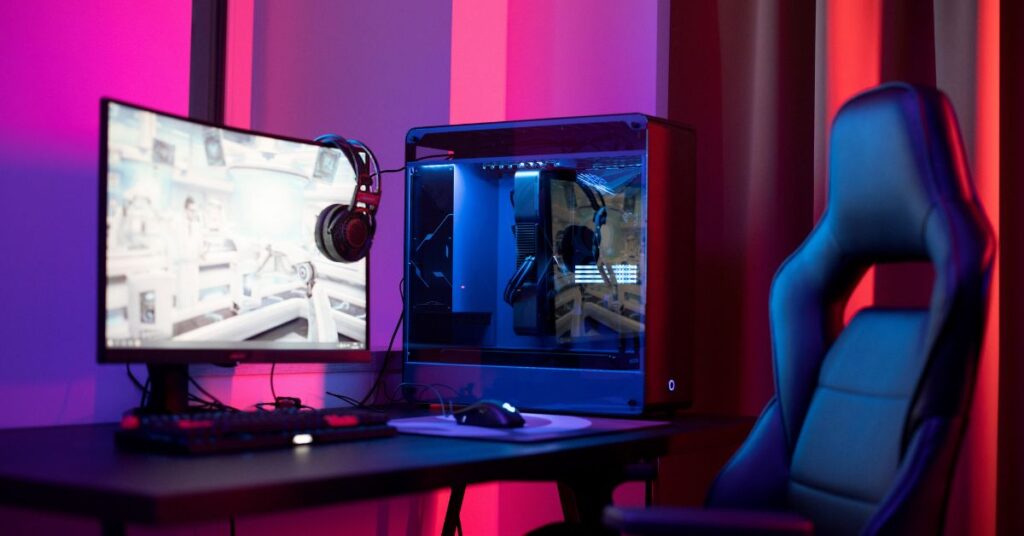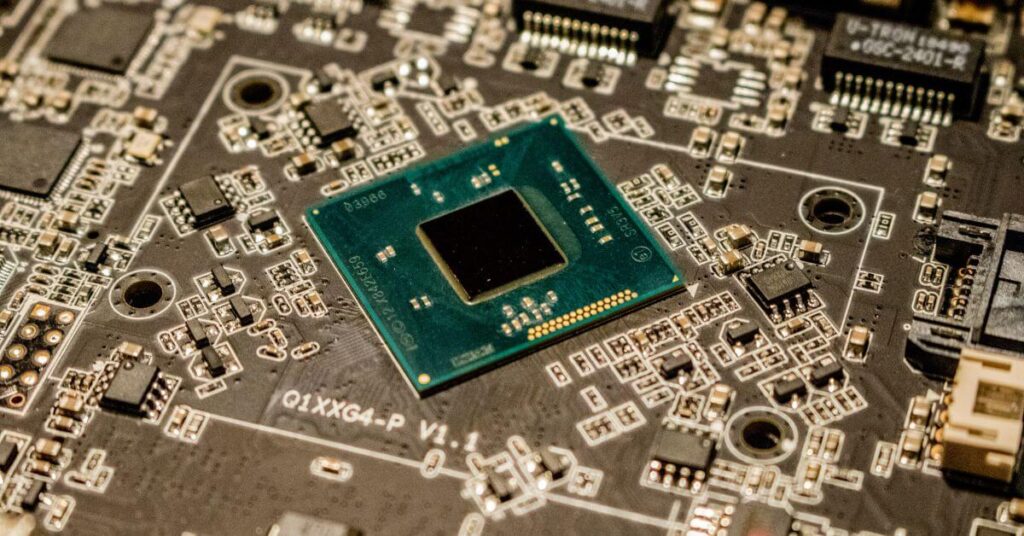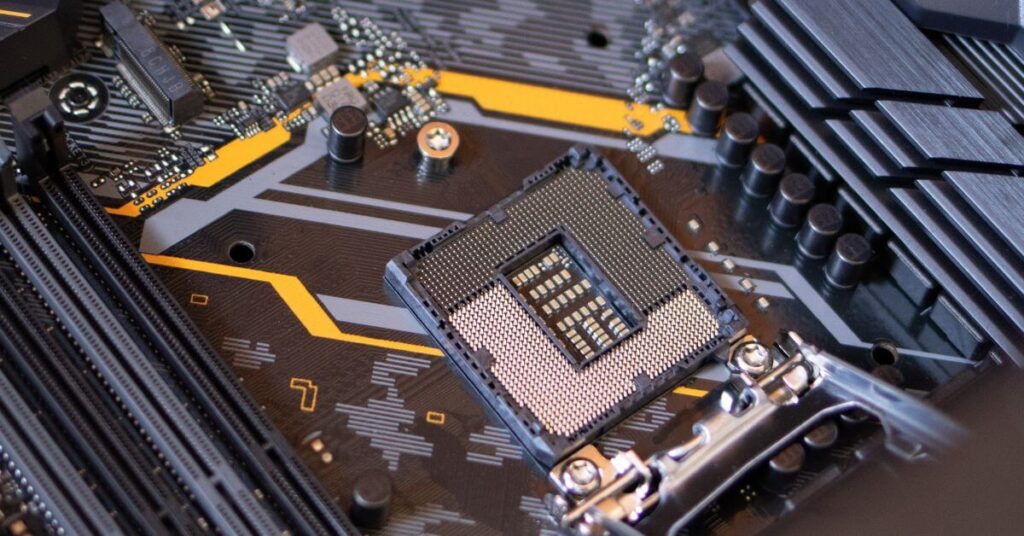Dive into the world of gaming with motherboards—the behind-the-scenes champs making your games run smoothly. Think of them as the traffic controllers, directing how fast things move and making sure your gaming setup stays strong. Learn how these boards impact your gaming experience, making everything work seamlessly. Let’s break down how does the motherboard affect gaming Performance, turning your gaming fun into a well-orchestrated masterpiece.
Table of Contents
What is the motherboard and does Motherboard Affect Gaming Performance?
The motherboard, which connects all of the main parts of a computer, is its primary circuit board. Yes, motherboards have a big impact on how well games work. They affect data transfer speeds, power supply, and system stability in general. A gaming rig’s motherboard is a critical component that determines how smoothly gameplay runs, whether it can be overclocked and whether it works with peripherals.

Chipset: The Core of Nerves
Meaning and Function of the Chipset
The motherboard’s nervous system, or chipset, allows various components to communicate with one another. It is essential for figuring out data transmission speeds, supporting peripherals, and making sure GPUs and CPUs work together.
Effect on the Performance of Games
- Rates of Data Transfer: For gaming, high-speed data communication is necessary. Modern chipsets offer quicker connections between the CPU, GPU, and RAM, which makes games run more smoothly.
- Support for Peripherals: A wide range of peripherals are frequently used in gaming. Compatibility with gaming keyboards, mice, and other peripherals is ensured with a well-matched chipset.
- CPU and GPU Compatibility: The CPU and GPU must work in harmony with the chipset. The performance of the newest gaming processors and graphics cards is optimized by modern chipsets.
VRM Design: Powering Performance
VRM’s role in power delivery
The Voltage Regulator Module (VRM) is in charge of providing the CPU with a steady power supply. Performance in games is directly impacted by a strong VRM architecture, particularly when overclocking is involved.
Effect on the Performance of Games
- Stability of Power Supply: For gaming, reliable power delivery is essential. Stability throughout long gaming sessions is ensured by high-quality VRM architecture, which reduces voltage fluctuations.
- Overclocking Capabilities: Hardware is frequently overclocked by passionate gamers. Overclocking is supported by a well-designed VRM, which improves gaming performance for gamers looking for an extra edge.
- Heat Generation and Cooling Needs: Heat generation is reduced via efficient VRM design. This is especially crucial to keep the temperature at the ideal level and avoid thermal throttling when playing for extended periods of time.
Expansion Slots: Gateway to Performance
- PCIe Slots and GPU Performance: PCIe slots dictate the communication between the motherboard and graphics card. The number and configuration of PCIe lanes impact GPU performance, influencing frame rates and overall gaming experience.
- M.2 Slots for Fast Storage: The availability of M.2 slots, especially those supporting NVMe SSDs, contributes to faster loading times in games. This directly affects level load times and in-game responsiveness.
- RAM Slots and Memory Support: The number of RAM slots and supported memory speeds influence multitasking capabilities and overall system responsiveness during gaming.
Why Motherboard Is Used?
Also, read this informative article for your computer.
BIOS/UEFI Firmware: The System Conductor
Role of BIOS/UEFI in System Initialization
The Basic Input/Output System (BIOS) or Unified Extensible Firmware Interface (UEFI) is responsible for initializing the system. A well-optimized firmware ensures a quick and smooth startup, minimizing downtime.
Impact on Gaming Performance
- BIOS Updates: Regular updates enhance motherboard compatibility with new hardware and may unlock performance improvements. Gamers should stay vigilant for updates that specifically address gaming-related optimizations.
- Overclocking Features and Stability: Gaming enthusiasts often engage in overclocking to boost performance. A feature-rich BIOS with intuitive controls can make this process more accessible while maintaining system stability.
- Compatibility with Gaming Peripherals: A gamer’s experience goes beyond the monitor and graphics card. BIOS features can enhance compatibility with gaming peripherals, offering customization options for RGB lighting, macro controls, and more.
Connectivity Options: Beyond the Basics
USB Ports for Gaming Peripherals
The number and type of USB ports influence the connection of gaming peripherals. A motherboard with ample USB ports ensures gamers can connect their mice, keyboards, controllers, and other accessories without compromises.
Ethernet and Wi-Fi Capabilities
Stable internet connectivity is crucial for online gaming. A motherboard with high-quality Ethernet and Wi-Fi capabilities ensures a lag-free gaming experience, especially in multiplayer scenarios.
Bluetooth Support
Many modern gaming peripherals, such as controllers and headsets, use Bluetooth connectivity. A motherboard with integrated Bluetooth support reduces the need for additional adapters, streamlining the gaming setup.
Impact of Audio Codecs on Gaming Audio Quality
Immersive audio is a vital component of the gaming experience. High-quality audio codecs on the motherboard contribute to clear and detailed in-game audio, enhancing the overall gaming atmosphere.

Form Factor: Size Matters
Different Motherboard Form Factors
Motherboards come in various form factors, including ATX, Micro-ATX, and Mini-ITX. The choice of form factor impacts the overall size of the gaming PC and, consequently, the available space for cooling solutions and expansion.
Impact on Gaming PC Build and Cooling Solutions
Smaller form factors might limit the available space for cooling solutions, potentially impacting thermal performance during demanding gaming sessions. Gamers should carefully consider the balance between form factor and cooling requirements.
Considerations for Compact Gaming Setups
For those aiming for a compact gaming setup, Mini-ITX motherboards provide a space-efficient solution. However, careful planning is required to ensure compatibility with other components and sufficient cooling.
Manufacturer and Build Quality: The Foundation of Reliability
Role of Motherboard Manufacturers
The reputation and track record of motherboard manufacturers matter. Established manufacturers often invest in research and development, leading to higher-quality products and better overall reliability.
Impact of Build Quality on Durability
A well-built motherboard can withstand the rigors of gaming, including heat stress and potential overclocking. Durability is a key factor, especially for gamers who engage in extended gaming sessions.
Reviews and Reputation
Before making a purchase, gamers should explore reviews and consider the reputation of the manufacturer. Real-world experiences from other gamers provide valuable insights into the performance and reliability of a specific motherboard model.
Are Installing Motherboard Drivers Necessary?
Also, read this informative article for your computer.
Case Compatibility: Ensuring a Perfect Fit
Relationship Between Motherboard Size and Case Compatibility
Choosing a compatible case is essential. The motherboard size must align with the case form factor to ensure a proper fit.
Impact on Cooling Solutions and Airflow
Proper case and motherboard compatibility contribute to efficient airflow, which is crucial for maintaining optimal temperatures. Overheating components can lead to performance throttling and reduced gaming performance.
Considerations for Cable Management
A well-designed case with cable management features simplifies the setup process and contributes to a clean and organized gaming space.

Real-World Performance Benchmarks: Putting Theory to the Test
Analysis of Gaming Benchmarks
Examining real-world gaming benchmarks provides practical insights into how different motherboards perform in gaming scenarios.
Comparison of Gaming Performance
Comparisons between motherboards with variations in chipset, VRM design, and other features help gamers make informed decisions based on their specific gaming needs and preferences.
User Experiences and Reviews
User reviews offer a glimpse into the real-world performance of motherboards in gaming setups. Common issues and praises from actual users can guide potential buyers in selecting the right motherboard.
Future Trends: Anticipating the Next Level
Emerging Technologies in Motherboard Design
The tech industry is dynamic, and motherboard design is no exception. Gamers should stay informed about emerging technologies that could impact gaming performance in the near future.
Expected Impact on Gaming Performance
New technologies may bring improvements in data transfer rates, power efficiency, and overall system responsiveness, directly influencing gaming performance.
Considerations for Future Upgrades
Gamers planning for the long term should consider future-proofing their systems by selecting motherboards that support upcoming technologies and standards.
Conclusion: Building the Ultimate Gaming Rig
Summary of Key Findings
Understanding the various facets of motherboard design is crucial for building the ultimate gaming rig. From chipset considerations to form factor choices, each element contributes to the overall gaming experience.
Recommendations for Gamers
Choosing the right motherboard involves a balance of features, performance, and budget. Gamers should prioritize components based on their gaming preferences and future upgrade plans.
Importance of a Balanced System
While the motherboard is a critical component, a balanced system, including a powerful CPU, GPU, and sufficient RAM, is essential for unlocking the full potential of gaming performance.
In conclusion, the motherboard is the unsung hero of the gaming setup, connecting and powering the components that bring virtual worlds to life. By understanding its nuances and considering key factors, gamers can elevate their gaming experience to new heights.
Frequently Asked Questions (FAQs)
Q: What is the significance of the chipset in gaming?
A: The chipset is crucial for gaming as it determines data transfer rates, supports peripherals and ensures compatibility with CPUs and GPUs. A well-optimized chipset contributes to smoother gameplay and overall system responsiveness.
Q: How does the number of USB ports on a motherboard affect gaming?
A: The number and type of USB ports influence the connection of gaming peripherals such as mice, keyboards, and controllers. Sufficient USB ports on a motherboard ensure gamers can connect their accessories without compromises.
Q: Is case compatibility important when choosing a motherboard for gaming?
A: Yes, case compatibility is crucial. The motherboard size must align with the case form factor to ensure a proper fit. Proper compatibility contributes to efficient cooling solutions and optimal airflow, preventing overheating during gaming.
Q: Do I need to update the BIOS for optimal gaming performance?
A: Regular BIOS updates can enhance motherboard compatibility with new hardware and may unlock performance improvements. It’s advisable to check for updates, especially when installing new components or experiencing compatibility issues.
